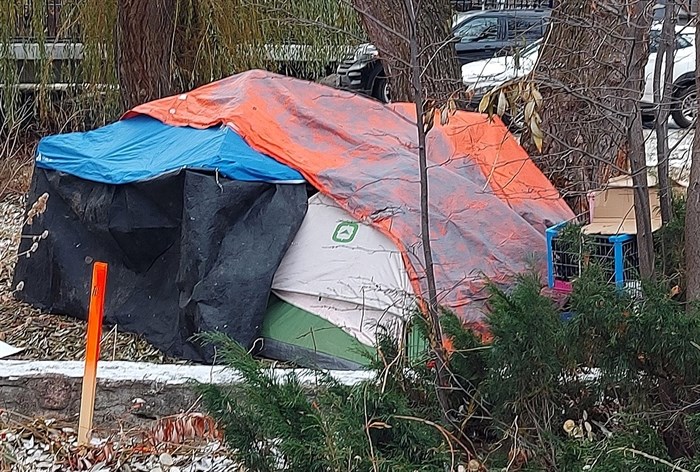Here’s what it costs to house the homeless
The City of Kelowna can’t say, or won’t say, how much it spends each year dealing with homelessness within city boundaries.
After repeated efforts to get those figures, the City told iNFOnews.ca in an email, that it will have to spent just over $1 million by the end of this year to help fund the Journey Home Society that once had a target to end functional homelessness by 2024.
That goal has been extended until some time in the future as the number of people sleeping rough on city streets this winter grew to an average of about 115 people a night, compared to 30 at the same time last year. Dozens more are forced to live in what were once considered temporary emergency shelters.
Some of those people are spending their nights in tents set up in, or near, the city’s “Designated Outdoor Shelter Site” near Richter Street and the Rail Trail.
That costs $39,000 a month – close to $500,000 per year – to manage, providing things like security, fencing and sanitation services.
Most of those costs, through to the end of July this year, are covered by a senior government grant, meaning the actual cost to the city for two years of operation will be $48,000.
Those are the only costs the City of Kelowna staff provided.
“We know there are significant staff/RCMP wages involved too, but do not have exact costs,” the email says.
Therein lies the problem.
There is very little information on what Canada’s homeless population is costing taxpayers.
READ MORE: Nuisance' Kamloops non-profit gets fewer emergency calls than other sites
The most recent and most comprehensive study was done by Eric Latimer and colleagues. Latimer is a research scientist at the Douglas Mental Health University Institute and a professor in the Department of Psychiatry at McGill University in Montreal.
The study followed hundreds of homeless people in five cities (Vancouver, Toronto, Montreal, Moncton and Winnipeg) for almost two years.
Some were given housing in apartments of their choice with rent supplements and support services (paid for by the study) while others were left to their own resources (dubbed Treatment as Usual).
They were interviewed every three months so researchers could record how often they went to emergency rooms, were admitted to hospitals, were arrested and/or jailed and what other services they required. From that the researchers could calculate the costs to taxpayers.
But that study is dated. The research was done from 2009-11. It was published in 2017 with costs adjusted to 2016 dollars.
Costs varied greatly by city and between individuals, depending on the level of mental issues the subjects were dealing with.
Those with moderate mental illness cost taxpayers almost $49,000 a year in 2022 dollars, on average, just to leave them to fend for themselves.
For those given housing and provided with services, it cost society about $9,500 more.
For those with more severe mental issues, the cost of no treatment was almost $67,000 in 2022 dollars. Those with housing and services cost about $7,500 a year more.
READ MORE: Is crime a legitimate concern for Kelowna supportive housing?
While this study is more than a decade old, Latimer, in an interview with iNFOnews.ca, said the results are just as reliable today.
“What we do with people experiencing homelessness hasn’t changed that much,” he said.
So, if it costs $7,500 to $9,500 more to house the homeless than leaving them to fend for themselves, why should society – that is, taxpayers – foot that extra bill?
Because, Latimer argued, that’s what we as a society do all the time for those who are not homeless.
“The key point I try to make is, if a 65- to 70-year-old person has osteoarthritis in their hips, we’re going to replace their hips,” he said. “We’re not going to ask ourselves: ‘Gee, are we going to be saving as much money from replacing their hips as the cost of the operation will be?’ The answer to that question is no. We’re not going to be saving a whole lot of money at all. But, we are going to improve their quality of life.”
Working age Canadians, in general, earn income, pay taxes and contribute more to society than they take out.
When they get older they may be living off their government pensions and have serious health issues that could cost $100,000 or $200,000 a year to the health care system.
That’s a huge drain on the system but something that’s rarely, if ever, questioned.
People often have a drastically different attitude when it comes to helping those who are homeless – often for short periods of time.
“There’s a kind of disconnect there which, I think, is actually rooted in the belief that, well, homeless people are homeless because it’s their fault,” Latimer said. “Basically it’s bad choices. It’s not uncommon for people experiencing homelessness to have made some bad choices but, if you look at the data, they’re not usually people who come from privileged backgrounds. A large number of them haven’t even finished high school, which tells you they come from pretty disadvantaged families to begin with.
“If you think about it too, if somebody shows up at the hospital with a heart attack, we don’t ask: ‘Have you been exercising the way you should? Have you been eating properly?’ We don’t ask them questions. We just treat the person. I think we should look at homelessness the same way we look at our health care conditions and be prepared to spend some money. The basic point is, it actually doesn’t cost that much, compared to what we currently do, to treat people decently the way we would like to be treated if we fell into homelessness.”
That kind of research isn’t being continued, likely because the study cost $110 million.
Of that, $15-$17 million was for the study itself. The rest went to provide housing subsidies and hire professionals to provide support services.
Latimer estimates it saved governments $40-$50 million not having to deal with the participants – some of whom wound up homeless again after the study ended because governments didn’t carry on with the housing supports.
Back in Kelowna, about 300 supportive housing units were built by B.C. Housing between 2018 and 2021.
But no more housing has been added since, despite the growing number of people living on the streets, partly due to skyrocketing housing costs.
Even without doing a detailed cost breakdown, the city’s community safety director – the man tasked with dealing with the reality of people sleeping rough – sees the need to do more.
“Sending police and fire and ambulances and responding to the risks and circumstances of unhoused individuals through the health and the criminal justice systems is a very expensive approach,” Darren Caul told iNFOnews.ca. “We know that and that’s why our primary attention is always around providing housing solutions foremost.”
Still, that doesn’t seem to be going nearly far enough as the homeless population continues to grow.
READ MORE: Kelowna's homeless population expected to double by 2026
To contact a reporter for this story, email Rob Munro or call 250-808-0143 or email the editor. You can also submit photos, videos or news tips to the newsroom and be entered to win a monthly prize draw.
We welcome your comments and opinions on our stories but play nice. We won't censor or delete comments unless they contain off-topic statements or links, unnecessary vulgarity, false facts, spam or obviously fake profiles. If you have any concerns about what you see in comments, email the editor in the link above.




